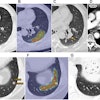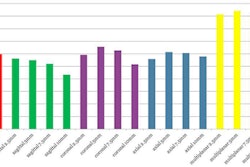An image analysis technique presented at the RSNA 2011 meeting could facilitate CT lung cancer screening by differentiating potentially malignant part-solid nodules from the transient kind that are less worrisome.
The problem with part-solid nodules (PSNs) detected at CT is that they have a much higher malignancy rate -- ranging from about 63% to 90% of all PSNs that don't resolve on their own -- compared with solid or ground-glass nodules. Still, about 50% to 70% of PSNs are transient, typically resolving on their own within a few weeks or months. And that waiting time is wasted time.
If radiologists could determine from the initial CT scan which part-solid nodules would resolve and which are more likely to be malignant, patients could be appropriately triaged, potentially sparing them and their doctors a lot of time, not to mention radiation dose, said researchers from Seoul, South Korea.
The study team believes it has a solution: Differentiation of the two types based on CT attenuation characteristics, which differ significantly between persistent and transient PSNs.
"It is important to determine whether initially detected PSNs would be transient or persistent," said Dr. Sang Hwan Lee from Seoul National University Hospital's National Cancer Center. "By doing so, we can reduce unnecessary invasive diagnostic procedures and radiation dose from follow-up CT."
The retrospective study aimed to use computer-aided analysis of nodules' pixel values to differentiate persistent from transient part-solid lesions.
Previous studies had looked at clinical and CT features in different ways, he said. Clinical predictors of transient PSNs included young age and blood eosinophilia. CT features suggestive of transient nodules included the presence of multiple PSNs, lesions with a large solid portion, and those with ill-defined margins. These signs work pretty well, but the group was aiming for results that were more patient-specific and, they hoped, more accurate.
"PSNs could be assessed with high accuracy by experts, but there was limited reproducibility," Lee said. "In this context, pixel-value analysis is a promising method."
For five years ending in December 2010, the researchers identified 77 CT screening patients (39 men, 38 women; mean age, 55 years) with PSNs (47 persistent in 46 individuals and 39 transient in 31) at thin-section CT. Two experienced radiologists working together identified the patients with PSNs.
Transient PSNs were defined as those that shrank or disappeared over the three-month follow-up period, while nodules labeled persistent either grew or remained stable.
The radiologists manually segmented each PSN into an inner solid and outer ground-glass opacity region. A range of pixel values from the segmented areas of each PSN was then extracted using computer-aided analysis software (ImageJ, version 1.43m, U.S. National Institutes of Health) and compared between persistent and transients PSNs.
Multivariate logistic regression analysis was used to identify any differential features between persistent and transient PSNs, and the diagnostic performance of this model was evaluated using C-statistics, Lee explained.
In a univariate analysis, standard pixel attenuation, standard deviation, and kurtosis (the extent of a peak or a bulge in the data) differed significantly between transient and persistent PSNs in the ground-glass portion of the lesions. The inner, solid portion showed no significant differences between the transient and persistent PSNs, Lee said.
Differences between transient and persistent PSNs
|
||||||||||||||||||||||||
| *Results apply to whole nodule only. Analyzed by itself, the inner solid portion showed no significant differences between the transient and persistent PSNs. |
In addition, multivariate analysis showed that higher standard deviation (p = 0) and higher kurtosis (p = 0.032) were statistically significant independent predictors of transient PSNs.
"Using computer-aided analysis from the whole pixel area, persistent and transient PSNs can be differentiated with high accuracy," Lee said.




















